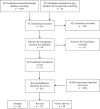Development of the Canadian Spinal Cord Injury Best Practice (Can-SCIP) Guideline: Methods and overview
- PMID: 34779719
- PMCID: PMC8604491
- DOI: 10.1080/10790268.2021.1953312
Development of the Canadian Spinal Cord Injury Best Practice (Can-SCIP) Guideline: Methods and overview
Abstract
Introduction: Spinal cord injury (SCI) is a life-altering injury that leads to a complex constellation of changes in an individual's sensory, motor, and autonomic function which is largely determined by the level and severity of cord impairment. Available SCI-specific clinical practice guidelines (CPG) address specific impairments, health conditions or a segment of the care continuum, however, fail to address all the important clinical questions arising throughout an individual's care journey. To address this gap, an interprofessional panel of experts in SCI convened to develop the Canadian Spinal Cord Injury Best Practice (Can-SCIP) Guideline. This article provides an overview of the methods underpinning the Can-SCIP Guideline process.
Methods: The Can-SCIP Guideline was developed using the Guidelines Adaptation Cycle. A comprehensive search for existing SCI-specific CPGs was conducted. The quality of eligible CPGs was evaluated using the Appraisal of Guidelines for Research and Evaluation II (AGREE II) instrument. An expert panel (n = 52) convened, and groups of relevant experts met to review and recommend adoption or refinement of existing recommendations or develop new recommendations based on evidence from systematic reviews conducted by the Spinal Cord Injury Research Evidence (SCIRE) team. The expert panel voted to approve selected recommendations using an online survey tool.
Results: The Can-SCIP Guideline includes 585 total recommendations from 41 guidelines, 96 recommendations that pertain to the Components of the Ideal SCI Care System section, and 489 recommendations that pertain to the Management of Secondary Health Conditions section. Most recommendations (n = 281, 48%) were adopted from existing guidelines without revision, 215 (36.8%) recommendations were revised for application in a Canadian context, and 89 recommendations (15.2%) were created de novo.
Conclusion: The Can-SCIP Guideline is the first living comprehensive guideline for adults with SCI in Canada across the care continuum.
Keywords: Clinical practice guidelines; Evidence-based practice; Knowledge translation; Spinal cord injury.
Figures
Similar articles
-
Evidence-based recommendations for the rehabilitation and management of the ageing population with spinal cord injury: a systematic review of clinical practice guidelines.Eur J Phys Rehabil Med. 2024 Jun;60(3):433-444. doi: 10.23736/S1973-9087.24.08244-3. Epub 2024 Mar 29. Eur J Phys Rehabil Med. 2024. PMID: 38551520 Free PMC article.
-
Evaluation of the quality of published SCI clinical practice guidelines using the AGREE II instrument: Results from Can-SCIP expert panel.J Spinal Cord Med. 2021;44(sup1):S69-S78. doi: 10.1080/10790268.2021.1961053. J Spinal Cord Med. 2021. PMID: 34779735 Free PMC article.
-
Translating the international scientific spinal cord injury exercise guidelines into community and clinical practice guidelines: a Canadian evidence-informed resource.Spinal Cord. 2020 Jun;58(6):647-657. doi: 10.1038/s41393-019-0410-1. Epub 2020 Jan 16. Spinal Cord. 2020. PMID: 31949284 Free PMC article.
-
An Update of a Clinical Practice Guideline for the Management of Patients With Acute Spinal Cord Injury: Recommendations on the Role and Timing of Decompressive Surgery.Global Spine J. 2024 Mar;14(3_suppl):174S-186S. doi: 10.1177/21925682231181883. Global Spine J. 2024. PMID: 38526922 Free PMC article.
-
Best practice care for persistent pain in adults with spinal cord injuries: a systematic review and narrative synthesis of clinical practice guideline recommendations.Disabil Rehabil. 2023 Jul;45(15):2539-2548. doi: 10.1080/09638288.2022.2093998. Epub 2022 Jul 10. Disabil Rehabil. 2023. PMID: 35815405
Cited by
-
Evidence-based recommendations for the rehabilitation and management of the ageing population with spinal cord injury: a systematic review of clinical practice guidelines.Eur J Phys Rehabil Med. 2024 Jun;60(3):433-444. doi: 10.23736/S1973-9087.24.08244-3. Epub 2024 Mar 29. Eur J Phys Rehabil Med. 2024. PMID: 38551520 Free PMC article.
-
FGF23 alleviates neuronal apoptosis and inflammation, and promotes locomotion recovery via activation of PI3K/AKT signalling in spinal cord injury.Exp Ther Med. 2023 May 22;26(1):340. doi: 10.3892/etm.2023.12039. eCollection 2023 Jul. Exp Ther Med. 2023. PMID: 37383378 Free PMC article.
-
Reframing the Science and Practice of Spinal Cord Injury Rehabilitation: Two Decades of Reflection.Top Spinal Cord Inj Rehabil. 2023 Fall;29(Suppl):iv-xi. doi: 10.46292/1945-5763-29.suppl.iv. Epub 2023 Nov 17. Top Spinal Cord Inj Rehabil. 2023. PMID: 38174127 Free PMC article. No abstract available.
-
From gaps to guidelines: a process for providing guidance to bridge evidence gaps.Biomed Eng Online. 2025 May 3;24(1):52. doi: 10.1186/s12938-025-01385-6. Biomed Eng Online. 2025. PMID: 40319264 Free PMC article.
-
What Is the Pathway to the Best Model of Care for Traumatic Spinal Cord Injury? Evidence-Based Guidance.Top Spinal Cord Inj Rehabil. 2023 Fall;29(Suppl):103-111. doi: 10.46292/sci23-00059S. Epub 2023 Nov 17. Top Spinal Cord Inj Rehabil. 2023. PMID: 38174142 Free PMC article.
References
-
- Hitzig SL, Escobar EMR, Noreau L, Craven BC.. Validation of the reintegration to normal living index for community-dwelling persons with chronic spinal cord injury. Arch Phys Med Rehabil 2012;93(1):108–14. - PubMed
-
- Carr JJ, Kendall MB, Amsters DI, Pershouse KJ, Kuipers P, Buettner P, et al. . Community participation for individuals with spinal cord injury living in Queensland, Australia. Spinal Cord 2017;55(2):192–7. - PubMed
-
- Guilcher SJT, Catharine Craven B, Bassett-Gunter RL, Cimino SR, Hitzig SL.. An examination of objective social disconnectedness and perceived social isolation among persons with spinal cord injury/dysfunction: a descriptive cross-sectional study. Disabil Rehabil 2019;43(1):1–7. - PubMed
-
- Craven BC, Balioussis C, Verrier M.. The tipping point: perspectives on SCI rehabilitation service gaps in Canada. Int J Phys Med Rehabil 2013;1(8):1–4.
-
- DeVivo MJ, Savic G, Frankel HL, Jamous MA, Soni BM, Charlifue S, et al. . Comparison of statistical methods for calculating life expectancy after spinal cord injury. Spinal Cord 2018;56(7):666–73. - PubMed
Publication types
MeSH terms
LinkOut - more resources
Full Text Sources
Other Literature Sources
Medical
Miscellaneous


